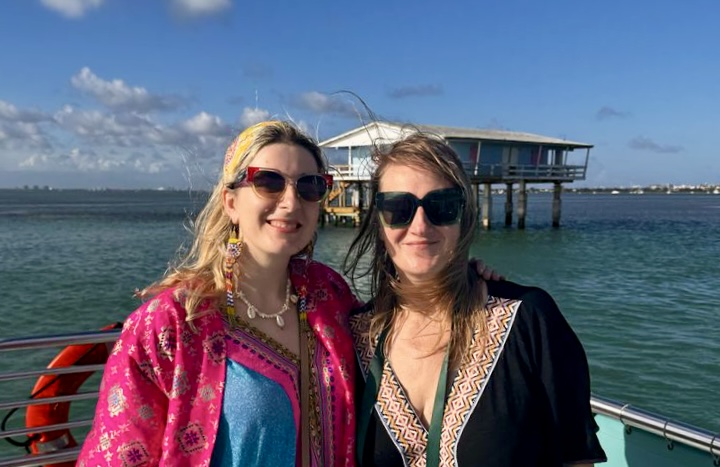An Interview with Residents Cécile Palusinski and Elsa Mroziewicz
New Media

Photo courtesy of Cécile Palusinski and Elsa Mroziewicz
Look back at Elsa Mroziewicz and Cécile Palusinski’s Villa Albertine residency in Miami, carried out in February 2025 around their Floating Cities project.
For the sixth stage of this augmented reality project, Miami offered them an immersion rich in encounters, at the heart of the environmental and urban issues of a territory directly confronted by rising waters.
Could you introduce yourselves and your project Villes Flottantes, which you worked on during your Villa Albertine residency in Miami?
We are Elsa Mroziewicz, visual artist and animation director, and Cécile Palusinski, author and sound designer, and we’ve been working together for over 10 years on artistic projects that question man’s relationship with nature. We previously worked on a project entitled Arbres-Mondes (Trees-Worlds), which took a mythological approach to understanding/hearing man’s relationship with forests and trees.
Our new project, Villes flottantes (Floating Cities), is a work of sound art in augmented reality, which this time around offers a poetic and literary vision of imaginary floating cities, while revealing solutions to ecological issues and the impact of human activities on the ocean.
Miami is the sixth city in the project. How does it differ from the other five cities, and how has it influenced the evolution of your Floating Cities project? What do you remember from your meetings and visits to Miami?
Because of its geographical location and climatic challenges (rising sea levels, recurrent flooding, hurricanes), Miami is a “patient zero” in the fight against rising sea levels. This city stands out from the rest in terms of the intensity and urgency of the challenges it faces. We were particularly interested in sustainable architecture initiatives, such as Arkup’s floating house project, or the projects of Jeffrey Huber, an architect specializing in sustainable architecture and adaptation to climate change, whose interdisciplinary work combines social sciences, ecology, and urban planning.
We were struck by the many real estate projects being built despite the threat of rising sea levels. There is undoubtedly a major challenge in raising awareness among residents. The Cleo Institute, for example, is taking exemplary action, developing programs aimed at women to promote climate resilience and empower communities.
During the residency, we gathered testimonies from scientists, ethnologists, architects, communities, and structures creating bridges between the arts and sciences, giving us a cross-disciplinary perspective on our research topic.
In what format and medium will the public be able to discover Floating Cities, and what types of venues or experiences do you envision to make it accessible to audiences ? Will it be seen in Miami?
Villes flottantes will be accessible in the form of six monumental, augmented reality sound panels (2*2.60 m per panel) to be displayed indoors or outdoors in public spaces. A leporello book will also be published to enable audiences to continue the experience at home, with access to complementary content, such as the interview videos produced during our various residencies. The public will be able to discover this work in contemporary art and science museums, media libraries, public events, festivals and international ocean conferences. In Miami, we’ve met with potential partners such as Filmgate and Ocinema, but it’s still a little early to announce venues. In any case, it’s important for us to distribute this work in the countries where we were in residence, in order to establish long-term collaborations with the people and structures we met during our residency at Villa Albertine.
Did this residency give rise to any new desires or creative avenues for the future? What other projects or aspirations do you have for the future?
During our residency, we lived in Wynwood, a district of Miami renowned for its many colorful murals. This also inspired us to think about a mural version of Villes flottantes, accessible to all in public spaces. We are also currently working on the production of an embroidered version of the work in collaboration with local artisans in India, Morocco, and Brazil, particularly in view of the Saison croisée France Brésil. Through embroidery, we plunge into a long creative process, contrasting with the pace of digital use, which imposes an accelerated relationship with time. This reflection on time, on the slowness of craftsmanship in the face of the instantaneity of technology, is an important aspect of our creative approach. Following on from Villes flottantes, we also plan to develop large-format pop-ups of our floating cities, to be animated in mixed reality, under the name Gardiens de l’Océan.
